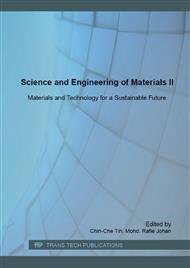[1]
A. Aslani, A. Morsali, V.T. Yilmaz, C. Kazak, Hydrothermal and sonochemical synthesis of a nano-sized 2D lead (II) coordination polymer: A precursor for nano-structured PbO and PbBr2, J. Mol. Struct. 929 (2009) 187-192.
DOI: 10.1016/j.molstruc.2009.04.026
Google Scholar
[2]
S. Allahyari, M. Haghighi, A. Ebadi, S. Hosseinzadeh, Ultrasound assisted co-precipitation of nanostructured CuO–ZnO–Al2O3 over HZSM-5: Effect of precursor and irradiation power on nanocatalyst properties and catalytic performance for direct syngas to DME, Ultrason. Sonochem. 21 (2014).
DOI: 10.1016/j.ultsonch.2013.09.014
Google Scholar
[3]
S. Khanjani, A. Morsali, A new nano-particles La III compound as a precursor for preparation of La2O2(SO4) nano-particles, J. Mol. Struct. 935 (2009) 27-31.
DOI: 10.1016/j.molstruc.2009.06.035
Google Scholar
[4]
A. Morsali, A. Panjehpour, Ultrasonic-assisted synthesis of nano-structured lead (II) coordination polymers as precursors for preparation of lead (II) oxide nanoparticles, Inorg. Chim. Acta. 391 (2012) 210-217.
DOI: 10.1016/j.ica.2012.04.024
Google Scholar
[5]
J.C. Yu, L. Zhang, Q. Li, K.W. Kwong, A. W. Xu, J. Lin, Sonochemical Preparation of Nanoporous: Composites of Titanium Oxide and Size-Tunable Strontium Titanate Crystals, Langmuir. 19 (2003) 7673-7675.
DOI: 10.1021/la0345035
Google Scholar
[6]
P. Awati, S. Awate, P. Shah, V. Ramaswamy, Photocatalytic decomposition of methylene blue using nanocrystalline anatase titania prepared by ultrasonic technique, Catal. Commun. 4 (2003) 393-400.
DOI: 10.1016/s1566-7367(03)00092-x
Google Scholar
[7]
D. Vollet, D. Donatti, A. Ibañez Ruiz, J. da Silva, About the nanoporosity elimination above 800 ◦C in xerogels prepared from TEOS sono-hydrolysis physica status solidi. (a), 196 (2003) 379-383.
DOI: 10.1002/pssa.200305948
Google Scholar
[8]
J. Liang, X. Jiang, G. Liu, Z. Deng, J. Zhuang, F. Li, Y. Li, Characterization and synthesis of pure ZrO2 nanopowders via sonochemical method, Mater. Res. Bull. 38 (2003) 161-168.
DOI: 10.1016/s0025-5408(02)01007-3
Google Scholar
[9]
P. Jabbarnezhad, M. Haghighi, P. Taghavinezhad, Sonochemical synthesis of NiMo/Al2O3–ZrO2 nanocatalyst: Effect of sonication and zirconia loading on catalytic properties and performance in hydrodesulfurization reaction, Fuel Process. Technol. 126 (2014).
DOI: 10.1016/j.fuproc.2014.04.011
Google Scholar
[10]
J. Gnanaraj, V. Pol, A. Gedanken, D. Aurbach, Improving the high-temperature performance of LiMn2O4 spinel electrodes by coating the active mass with MgO via a sonochemical method, Electrochem. Commun. 5 (2003) 940-945.
DOI: 10.1016/j.elecom.2003.08.012
Google Scholar
[11]
K.S. Suslick, S.B. Choe, A.A. Cichowlas, M.W. Grinstaff, Sonochemical synthesis of amorphous iron, Nature. 353 (1991) 414-416.
DOI: 10.1038/353414a0
Google Scholar
[12]
R.R. Ramos, C. Bolívar, J. Castillo, J. Hung, C.E. Scott, Ultrasound assisted synthesis of nanometric Ni, Co, NiMo and CoMo HDS catalysts, Catal. Today. 133 (2008) 277-281.
DOI: 10.1016/j.cattod.2007.12.048
Google Scholar
[13]
O.O. James, S. Maity, M.A. Mesubi, L.A. Usman, K.O. Ajanaku, T.O. Siyanbola, S. Sahu, R. Chaubey, A review on conversion of triglycerides to on-specification diesel fuels without additional inputs, Int. J. of Ener. Res. 36 (2012) 691-702.
DOI: 10.1002/er.2894
Google Scholar
[14]
Y. Vafaeian, M. Haghighi, S. Aghamohammadi, Ultrasound assisted dispersion of different amount of Ni over ZSM-5 used as nanostructured catalyst for hydrogen production via CO2 reforming of methane, Energy Convers. Manage. 76 (2013) 1093-1103.
DOI: 10.1016/j.enconman.2013.08.010
Google Scholar
[15]
P. Estifaee, M. Haghighi, N. Mohammadi, F. Rahmani, CO oxidation over sonochemically synthesized Pd–Cu/Al2O3 nanocatalyst used in hydrogen purification: Effect of Pd loading and ultrasound irradiation time, Ultrason. Sonochem. 21 (2014).
DOI: 10.1016/j.ultsonch.2013.11.019
Google Scholar


